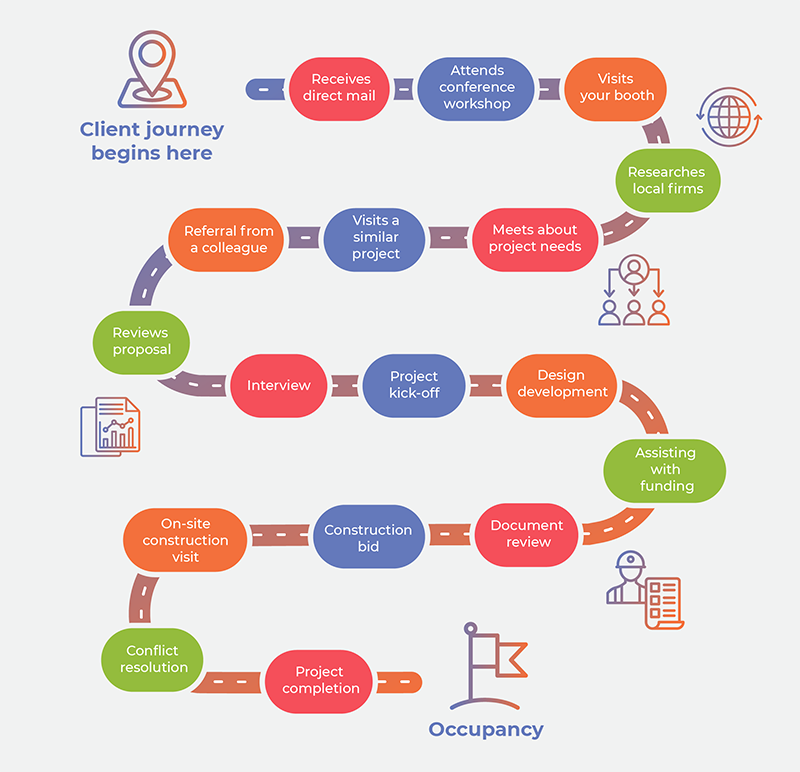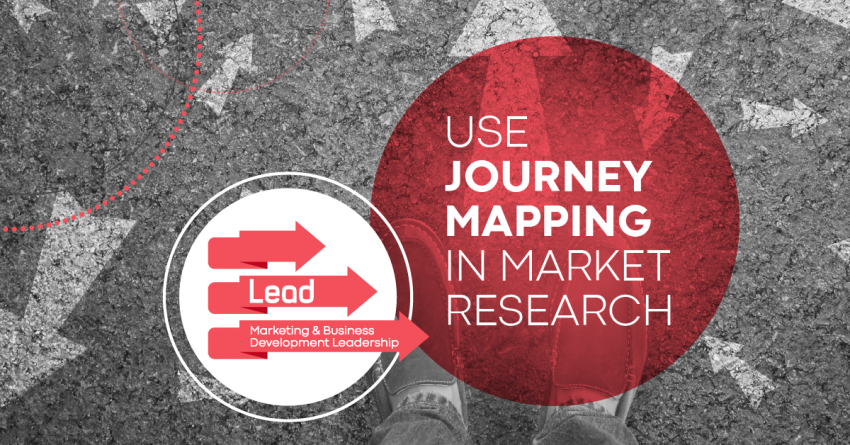Guidance for AEC Industry Marketing and Business Development Leadership
Marketing and business development leaders are not typically known as statisticians, math experts, or numbers gurus. We are usually known for the creative and strategic side of the technical AEC industry. So how can we be expected to conduct and analyze the market research needed for our strategic initiatives?
The good news is there’s a growing trend in market research called journey mapping. It’s a form of market research that plays on the creative strengths for those who consider themselves “mathematically challenged.”
Although journey maps are based on the data and statistics behind our clients’ decision-making process, the actual map itself can be understood by all. Creating a data-driven journey map will help you understand how your clients interact with your firm.
This new approach to market research is a helpful addition to our AEC marketing toolbox.
What is Journey Mapping in AEC Market Research?
Journey mapping is the process of tracking all touchpoints and interactions a client or customer has with a company, organization, or brand into one path that defines how they purchase. It is a technique used in market research, client surveys, marketing strategy, and operations. It outlines all of the potential touchpoints a client or potential client has on their path to purchase your company’s service.
Journey mapping will force your firm to think about market research differently—not as a one-time activity, but as an ongoing service that integrates all facets of an organization.
Example of Journey Mapping in for an AEC Company
Journey maps are graphically appealing, which means the deliverable helps us to digest and display insights and numbers in an easily comprehended and visually appealing fashion. The maps should ultimately become pieces of information to share with all teams or departments in an organization, not just the math nerds.
For example, pick an architectural firm. Now think of the potential touchpoints a new client has with that firm, from the time they decide they may require design and construction services to when they celebrate the first anniversary of being in the building.

A journey map highlights all of the relevant touchpoints for the organization.
Here are just a few of the touchpoints outlined in this architectural firm’s journey map:
- Company website. How does the client look up, review, and confirm what they have heard about your firm on your site?
- Marketing materials. Consider the client’s receipt and reaction to your direct mail, proposals, sponsorship materials, brochures, business cards, and more.
- In-person interaction. A client can come into contact with firm representative in many ways. This may include meeting a team member at an association meeting, talking to a business development professional on the phone, visiting your office, listening to your firm representatives during an interview, or working closely with a project manager during a project.
These are very simple examples of typical touchpoints. Still, each of these touchpoints has other points of contact within them that should receive further analysis.
The Importance of AEC Industry Journey Mapping
1. Gain an understanding of your client’s full experience.
Journey mapping helps your organization understand the entire client experience, including every touchpoint along the way. A physical map enables you to understand all journey points that can be missed by quantitative surveying.
For example, a journey map might detail a client’s impressions when reviewing your marketing materials in a typical market research scenario. Answering a question such as, “Describe ABC Architecture’s marketing message as reviewed in their brochure” is often difficult to assess or measure with an online survey.
2. Visualize client “purchasing” patterns.
Identifying all touchpoints helps an AEC firm understand how clients interact along the way. It helps a firm visualize patterns. By first identifying them, you can then discover ways to monitor and measure them.
3. Identify gaps in your current client relations and business development processes.
Journey mapping will also help you identify gaps in your current client relations and business development processes where you are not obtaining feedback.
This is the ultimate goal of AEC journey mapping: to ensure all important touchpoints have a measurement tool to monitor them.
Let’s say an engineering firm conducts a proposal debriefing survey and finds out that a selection committee member reviewed their website prior to the interview. This debriefing interview may let you know that they could find your portfolio and team information, but does it explore the client’s full experience of your website?
A journey map can help you understand and emphasize specific areas of the client’s journey that need more attention and improvement.
It can help you understand all the steps they take, from how they research and plan for project needs to how they meet design and construction professionals and those professionals’ influence on their project knowledge. How do they conduct design team selection—through bidding, proposals, or interviews? What are their service expectations during a project? Are there post-project impressions and referral opportunities?
Journey Mapping Process Work in Market Research
Step #1: Conduct a Client Survey
Two critical perspectives to map out are:
- Your firm’s view of the client’s consultant selection journey.
- The clients’ views of the journey.
Understand that these may be very different, but you need to map and understand both. What your firm views as a strength in the client journey may not be viewed as a strength by your clients. This is often why an organization starts with a broad client survey as a first step before drawing a journey map.
Step #2: Create a Comprehensive Map of the Client Journey
Once you understand the activities, you will need to create a comprehensive map and overview of the journey, including each touchpoint (no matter how minor).
During this process, you must identify ways to measure each touchpoint.
- What does a good experience look like at each stage?
- Does the interaction leave an impression of your service philosophy? For example, are you considered creative, responsive, and cost-effective? Or innovative, quality documents, and problem-solving?
List ways to measure this through secondary data or primary market research.
Step #3: Identify Areas of Opportunity
Finally, identify the areas that need the most improvement. These touchpoints become your priority focus for the next steps and guide your firm’s overall strategic plan.
The ultimate goal of a client journey map is to make the following claim:
“We reviewed our typical clients’ journey from Steps A to J. We can measure 80% of these steps currently. Still, we realized that among the 20% that are not currently measured, two of those unmeasured steps greatly impact innovation, client loyalty, and responsiveness of our firm professionals. We need to examine these priority areas through additional market research.”
This solution statement is a typical next step or recommendation from client journey mapping that you can present to firm leaders during the planning process.
As with any research, a journey map answers many questions for your organization but will also likely raise a few others, leading to continual improvement.






